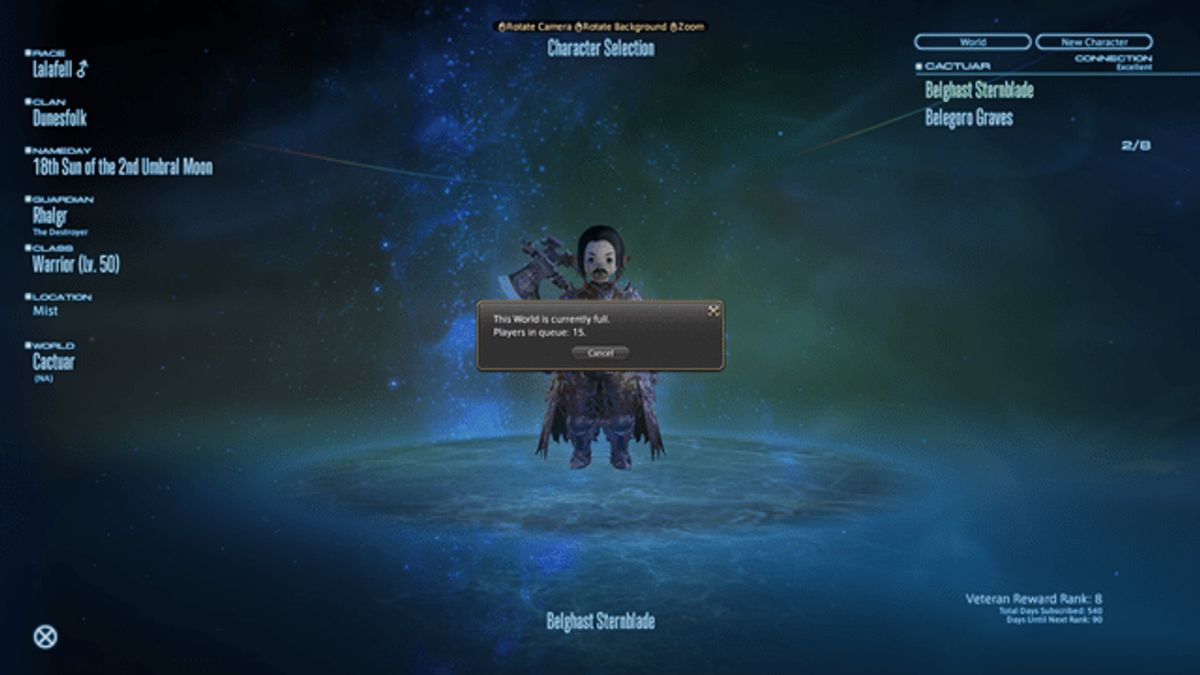Table of Contents
Final Fantasy XIV (FFXIV) has undergone remarkable transformations over time, with its data center arrangement playing a significant role in these changes. This article delves into the intricacies of FFXIV’s data centers, examining how they affect everything from gameplay mechanics to community dynamics and technological evolution. We will explore the impact of server technology on player experience, the technological advancements that have redefined the game, and the social fabric that binds the FFXIV community together. Additionally, we’ll look at how strategic server placement influences content updates and storytelling, and what the future may hold for FFXIV and its data centers.
Key Takeaways
- FFXIV’s data center arrangement enhances player experience by optimizing server technology for smooth gameplay and fostering community engagement.
- Technological evolution, from turn-based to real-time combat and improved graphical fidelity, has dramatically reshaped the FFXIV experience.
- Data centers are pivotal in community building, enabling players to form lasting relationships and engage in player-driven events within the game.
- Strategic server placement is essential for maintaining stable online environments and facilitating the rollout of large-scale content updates.
- The future of FFXIV is expected to see further advancements in technology, gameplay mechanics, and data center innovations that promote community growth.
The Role of Data Centers in Player Experience

Optimizing Server Technology for Smooth Gameplay
The choice of server technology and configuration is a critical factor in ensuring smooth gameplay for players. By focusing on traffic management, security, and loading times, developers can create a more responsive and engaging world.
- Traffic Management: Efficient handling of simultaneous player connections.
- Security: Robust protection against potential threats and exploits.
- Loading Times: Faster access to game content and smoother transitions.
By optimizing server infrastructure, developers can create a more responsive and engaging world for players, where the sense of community and cooperation is strengthened.
The comparison of client-server and peer-to-peer architectures reveals that the central computer in a client-server setup requires more resources and maintenance. However, both architectures have their own set of pros and cons based on factors like affordability and maintenance.
Balancing Load and Latency for Peak Performance
In the competitive landscape of MMORPGs, balancing server load and reducing latency are pivotal for a fluid gaming experience. FFXIV’s data centers are strategically designed to distribute the player base, ensuring no server bears too much weight. This careful balance is a blend of technical precision and geographical savvy, as the distance to servers can greatly influence a player’s latency.
- Server Load Distribution: Prevents server overload.
- Geographical Placement: Minimizes latency for nearby players.
- Resource Allocation: Maintains performance during high traffic.
By adeptly managing these factors, developers create a stable and responsive environment, crucial for the real-time demands of FFXIV’s gameplay.
The technology and configuration of servers are vital, as players often look for guides to enhance their connection and select the best server. This focus on server technology underscores its significance in the overall gaming experience. The challenge is to anticipate player behavior and peak times, requiring a deep understanding of community and usage patterns. Data centers must be agile, scaling resources to maintain a balance between load and latency, which is essential for a thriving community.
Community Building and Social Interaction
In the realm of FFXIV, data centers are more than just server clusters; they are the heart of the game’s social structure. Data centers are essential for community building, providing the necessary infrastructure for players to engage with one another, share experiences, and forge lasting relationships within the game’s universe.
- Data centers facilitate regional communities, ensuring that players can connect with others in their area, reducing language barriers and ping times.
- They also host special in-game events that bring players together, creating a vibrant, active community.
- Cross-world visit systems within data centers allow for a seamless mingling of players, enhancing the social aspect of the game.
The architecture of data centers in MMORPGs like FFXIV is pivotal for fostering a strong sense of community among players. These virtual spaces are not just technical infrastructures but also social hubs where shared experiences and memories are created.
The challenge lies in predicting player behavior and peak times, which requires a sophisticated understanding of the game’s community and usage patterns. This adaptability is key to maintaining an equilibrium between load and latency, thus fostering a vibrant and active community within each data center.
Technological Evolution and Its Impact on FFXIV

From Turn-Based to Real-Time: The Combat Transformation
The transition from turn-based to real-time combat in Final Fantasy XIV (FFXIV) represents a pivotal shift in the series’ approach to gameplay. This evolution began with earlier titles, where the Active Time Battle (ATB) system introduced a hybrid experience, blending turn-based elements with the need for timely decision-making. FFXIV took this further, creating a dynamic environment where players must engage in combat with immediacy and tactical awareness.
The real-time combat system in FFXIV demands that players not only strategize but also execute their moves with precision and adapt to rapidly changing battle conditions. This has led to a more engaging and challenging experience, where success hinges on both quick thinking and skillful play.
The real-time system enhances the sense of immersion and urgency in gameplay, making every encounter a test of player ability and adaptability.
As the series has progressed, the combat mechanics have continued to evolve, ensuring that each new installment offers a fresh and exciting challenge to players. The table below outlines the progression of combat systems in the Final Fantasy series:
| Title | Combat System | Notable Features |
|---|---|---|
| FFIV | ATB | Hybrid turn-based with real-time elements |
| FFXI | Real-Time | Continuous action combat system |
| FFXII | ADB | Mixture of strategic planning and real-time execution |
| FFXIV | Fully Real-Time | Emphasis on immediate action and player skill |
While some fans express nostalgia for the turn-based systems of the past, the current direction of FFXIV’s combat continues to attract a broad audience, eager for the thrill of real-time battles.
Graphical Fidelity and Immersive World-Building
In the expansive universe of Final Fantasy XIV, graphical fidelity is not just a technical achievement but a narrative tool. The game’s visual design intricately weaves together the elements of light, shadow, and color to create a world that feels alive and teeming with possibilities. The dichotomy of cutscene and gameplay visuals serves to enhance the narrative structure, offering players a seamless transition between story and action.
The visual cues in these spaces are meticulously crafted, guiding players through the game’s early stages with environmental storytelling. This attention to detail ensures that every corner of Eorzea tells a part of its grand saga, inviting players to explore and discover the lore embedded within its landscapes.
The evolution of graphical fidelity in FFXIV has seen a comparative analysis with previous Final Fantasy titles, showcasing a clear trajectory of improvement and ambition. The role of graphics in storytelling and atmosphere cannot be overstated, as it provides the foundation for the illusion of open-world exploration and influences dungeon design, all while maintaining a balance between linear storytelling and player freedom.
Voice Acting and Narrative Depth
The introduction of voice acting in Final Fantasy XIV (FFXIV) was more than a mere technological upgrade; it represented a paradigm shift in the game’s narrative delivery. Voice acting allowed characters to express a wider range of emotions, making the story more intimate and the world of Eorzea more vibrant. The impact was profound, with players reporting a deeper connection to the game’s lore and a heightened sense of immersion.
The evolution of voice acting in FFXIV also mirrors the industry’s push towards more sophisticated storytelling. With the use of powerful hardware, the game delivers a cinematic experience that rivals modern film narratives. This has not only enhanced the dramatic weight of the story but also changed how players interact with the game world.
While some players miss the charm of text-based dialogue, the majority view voice acting as a significant enhancement to the gaming experience. It has expanded the emotional range of the series, moving beyond the ‘puppet show’ aesthetic of earlier titles.
The balance between player agency and character autonomy is a delicate one. Voice acting has the potential to either bridge or widen this gap, depending on how it’s implemented. FFXIV strives to maintain this balance, ensuring that players remain the central drivers of their own adventures, even as they are drawn into the game’s rich narrative tapestry.
Community Dynamics within FFXIV Data Centers

Forming Friendships and Alliances
In the vast world of FFXIV, data centers are more than just a collection of servers; they are the birthplace of camaraderie and strategic alliances. Players often find themselves bonding over common goals and the thrill of conquering challenges together. This shared journey is not only about the battles fought but also about the relationships forged along the way.
- Common goals and similar experience in the duty
- Agreeing on encounter strategies
- Completing high-end content
The Party Finder tool is a testament to the game’s commitment to community building within data centers. It allows for the formation of unrestricted parties, facilitating the assembly of like-minded adventurers. Whether it’s tackling the latest Savage raid or embarking on a treasure hunt, the tool’s versatility is crucial for players seeking to customize their group dynamics.
The architecture of data centers in MMORPGs like FFXIV is pivotal for fostering a strong sense of community among players.
With the right mix of players, an ordinary quest can transform into an unforgettable adventure, creating bonds that transcend the digital realm. The data center’s role in enabling these connections is indispensable, laying the groundwork for a vibrant and interactive community.
Guilds and Player-Driven Events
In the vibrant world of FFXIV, guilds and player-driven events are the cornerstone of community engagement. These groups, known as Free Companies, provide a structured environment for players to form lasting friendships, collaborate on in-game projects, and participate in exclusive events. The introduction of new housing areas, such as the Empyreum in Ishgard, has further enabled guilds to create communal spaces where members can gather and socialize.
The game’s Community Wall feature acts as a hub for these activities, listing everything from party recruitments to Free Company announcements. Players can filter this information to stay updated on the latest events and opportunities for collaboration within their Data Center. Here’s a glimpse of the Community Wall’s functionality:
- Blog
- Event & Party Recruitment
- Free Company
- Eorzea Database
- Standings
- PvP Team
- Community Finder
The expanded World Visit system has revolutionized cross-regional play, allowing adventurers to attend events and join forces with guilds across different data centers. This has not only enriched the game’s social fabric but also diversified the types of events and interactions available to players.
Cross-Regional Play and Global Interaction
The introduction of cross-world visit systems within data centers has revolutionized the way players interact in FFXIV. This feature allows adventurers from different servers within the same data center to visit each other’s worlds, fostering a sense of global community and collaboration.
- Data centers facilitate regional communities, ensuring that players can connect with others in their area, reducing language barriers and ping times.
- They also host special in-game events that bring players together, creating a vibrant, active community.
- Cross-world visit systems within data centers allow for a seamless mingling of players, enhancing the social aspect of the game.
The expansion of data centers, including the addition for the Oceania region, has been a game-changer for players in remote locations. It has allowed for better connections and a more inclusive gaming experience for everyone involved.
Environmental interaction in FFXIV has also seen substantial advancements, adding layers of complexity to gameplay and making the world feel more alive. Enhanced camera flexibility, improved object manipulation, and dynamic event triggering are just a few examples of how the game’s world responds to player actions, enriching the cross-regional play experience.
Strategic Server Placement and Game Content Updates

Ensuring Stable and Responsive Online Environments
The strategic placement of data centers is a cornerstone in delivering a seamless gaming experience. Efficient traffic management is essential to handle the influx of simultaneous player connections, ensuring that no single server is overburdened and that gameplay remains smooth.
- Traffic Management: Efficient handling of simultaneous player connections.
- Security: Robust protection against potential threats and exploits.
- Loading Times: Faster access to game content and smoother transitions.
Resource allocation is another critical aspect, particularly during peak hours. By optimizing server load distribution and considering the geographical placement of servers, developers can minimize latency and maximize performance for players worldwide.
By optimizing server infrastructure, developers can create a more responsive and engaging world for players, where the sense of community and cooperation is strengthened.
The choice of server technology and configuration can significantly impact gameplay. Players often seek guides on setting up their connections and choosing the right server plan to optimize their individual gaming experience. This attention to detail reflects the importance of server technology in the overall quality of an MMORPG.
Framework for Large-Scale Content Rollouts
The strategic placement of data centers is crucial for the deployment of large-scale content updates in FFXIV. These updates are not just about adding new quests or areas; they often include complex changes to the game’s mechanics and require a robust infrastructure to ensure a smooth rollout.
- Predicting player behavior and peak times is essential for a successful update.
- Data centers must be agile, scaling resources to maintain equilibrium between load and latency.
- A successful rollout fosters a vibrant community, with players experiencing new content simultaneously.
The adaptability of data centers is key to maintaining a seamless player experience during content updates, ensuring that the community can engage with new challenges and adventures without interruption.
Understanding the community and usage patterns is fundamental to this process. By analyzing these patterns, developers can schedule updates during off-peak hours, minimizing disruptions and maximizing enjoyment for the player base.
Impact on Linear Storytelling and Player Engagement
The narrative structure of FFXIV, with its linear storytelling, plays a pivotal role in shaping the player’s journey. This approach ensures a cohesive and well-paced narrative, but it also brings about a set of advantages and disadvantages that impact player engagement.
Advantages and Disadvantages of Linear Storytelling in FFXIV:
-
Ensures a cohesive and well-paced narrative.
-
Allows for deep character development and plot twists.
-
Provides a clear direction and purpose for the player.
-
Can limit player agency and freedom.
-
May lead to a predictable gameplay structure.
-
Potentially reduces replayability due to a set story path.
The balance between storytelling and gameplay is a delicate one, where the former often takes precedence, guiding players through a meticulously crafted experience. This balance is crucial for maintaining player engagement and ensuring that the story unfolds in a manner that is both compelling and satisfying.
Looking Ahead: The Future of FFXIV and Its Data Centers

Anticipated Technological Advancements
The seamless integration of advanced technologies into Final Fantasy XIV’s data centers is not just a dream but a near-future reality. With each new installment, the series has embraced innovations that redefine the player experience. Below is a list of potential technological developments that could significantly impact gameplay and player immersion:
- Advanced AI systems for more dynamic and responsive NPCs
- Enhanced physics engines for more realistic environmental interactions
- Greater emphasis on cloud gaming to facilitate cross-platform play
- Implementation of virtual reality elements to deepen immersion
The introduction of these technologies is not solely about attracting newcomers but also about enriching the experience for long-standing fans. As we look to the future, the potential shifts in narrative and design philosophy suggest a transformative era for Final Fantasy XIV, where gameplay mechanics and environmental storytelling become more integrated and immersive than ever before.
Gameplay Mechanics and Future Expectations
As we look to the horizon, the future of Final Fantasy XIV is poised to embrace a new era of gameplay mechanics, driven by both technological innovation and player expectations. The community’s anticipation is palpable, with discussions often centered around the potential for more dynamic and responsive NPCs, thanks to advanced AI systems, and the desire for more realistic environmental interactions through enhanced physics engines.
The evolution of gameplay is not just about the mechanics themselves, but also about how they integrate with the narrative and design philosophy of the game. A greater emphasis on cloud gaming could facilitate seamless cross-platform play, expanding the boundaries of the FFXIV universe and fostering a more inclusive community. Moreover, the implementation of virtual reality elements could offer an unprecedented level of immersion, allowing players to step into the shoes of their characters like never before.
The seamless integration of cutting-edge technology with beloved gameplay elements is a cornerstone of the series’ progression.
Below is a list of potential technological developments that could shape the future of Final Fantasy gameplay:
- Advanced AI systems for NPCs
- Enhanced physics engines for environmental interactions
- Cloud gaming for cross-platform play
- Virtual reality elements for deeper immersion
Data Center Innovations and Community Growth
As Final Fantasy XIV continues to expand, the innovations in data center technology play a pivotal role in shaping the game’s community. The agility of data centers to scale resources to match player activity is crucial for a thriving online world.
Data centers are not just technical structures; they are the heart of community engagement. They enable players to form connections, participate in events, and experience the game’s culture. The following points highlight the community benefits facilitated by data center innovations:
- Enhanced regional communities through localized servers
- Special in-game events that foster player interaction
- Cross-world visit systems allowing for seamless social mingling
By ensuring a stable and responsive gaming environment, data centers are foundational to a rich, multiplayer experience that is both inclusive and engaging.
Looking to the future, we can expect data center technology to continue evolving, further enhancing the social fabric of FFXIV. This evolution will likely include more sophisticated load balancing, improved latency management, and innovative features that support the game’s growing global community.
Conclusion
As we’ve delved into the intricacies of FFXIV’s data center arrangement, it’s clear that this infrastructure is more than just a technical necessity; it’s a cornerstone of the game’s community and performance. The strategic placement of data centers has a profound impact on gameplay, ensuring smooth, stable interactions and fostering a global community where friendships and alliances thrive. From the evolution of game mechanics to the integration of voice acting and real-time combat, the data centers support and enhance the player experience in every aspect. As technology continues to advance, we can expect Square Enix to further optimize these virtual spaces, not only to maintain the high standards of gameplay smoothness and player satisfaction but also to continue nurturing the vibrant community that makes FFXIV a standout MMORPG. Whether you’re a seasoned veteran or a newcomer to the realm of Eorzea, understanding the role of data centers is key to appreciating the full scope of what FFXIV has to offer.
Frequently Asked Questions
How does FFXIV’s data center arrangement impact gameplay?
FFXIV’s data center arrangement is crucial for ensuring stable and responsive online interactions, facilitating community engagement, and providing a framework for large-scale content updates and cross-regional play.
What role do data center arrangements play in MMORPGs like FFXIV?
Data center arrangements in MMORPGs are essential for optimizing server technology, balancing load and latency to ensure optimal performance, and fostering community building within data centers.
How have gameplay mechanics evolved in Final Fantasy over the years?
Gameplay mechanics in Final Fantasy have evolved from turn-based to real-time combat, with the integration of voice acting and more complex narratives, offering a more immersive and dynamic gameplay experience.
How does graphical fidelity contribute to world-building in Final Fantasy?
Graphical fidelity is key to creating immersive and believable worlds in Final Fantasy, enhancing the storytelling and player immersion through detailed environments, character models, and visual effects.
What impact does linear storytelling have on gameplay in FFXIV?
Linear storytelling in FFXIV leads to a focused narrative experience, guiding players through a structured plot while ensuring a cohesive and engaging story progression within the game’s vast world.
What are the expectations for the future of Final Fantasy in terms of gameplay and technology?
Expectations for the future of Final Fantasy include further advancements in gameplay mechanics, enhanced graphical fidelity, innovative data center technologies, and a continued focus on community-driven features and content.





